How to Survive a Grizzly Bear Attack

Learning bear behavior is key to avoiding and surviving grizzly bear attacks. To make this article more accessible I’ve recorded an audio version here. The text follows.
Brown Bear (Grizzly Bear) Basics
Brown bears are the most widespread and diverse of the eight species of bears. They can run at speeds of over 30 mph and have long claws! They can climb trees and swim well. Even small brown bears are in the 300 lb range. The largest ever was a brown bear on Kodiak Island that was 1,656 lbs and 9.8 feet tall.
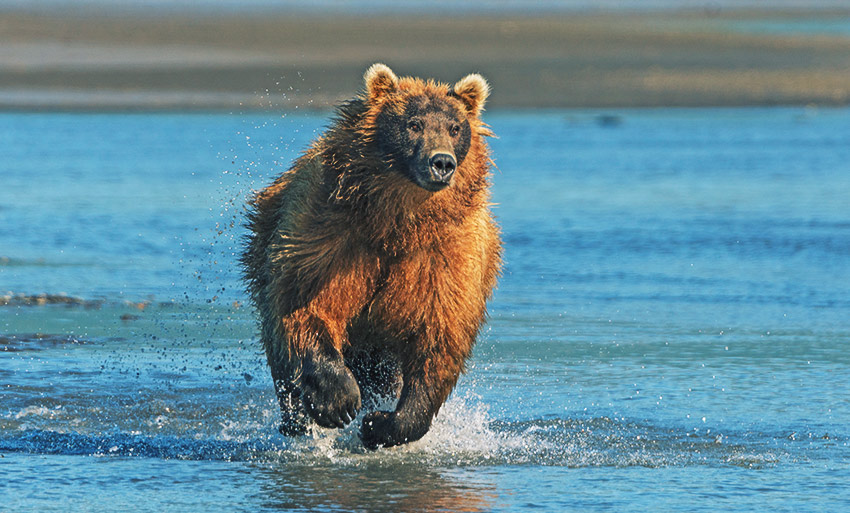
Just on size alone, you probably already realize you don’t want to mess with a bear. You don’t want to get in their way, no matter what they’re doing and you definitely want to know a lot about their behavior so you don’t fall victim to a brown bear encounter.
Lucky for you, there are ways to avoid brown bear attacks.
To start, it’s important to understand that all bears are really smart. They can solve complex problems and have great memories. That means they’ll learn how to interact with humans if given the chance. They’ll use these experiences to decide whether or not you’re a threat or if you are potential food.
Secondly, it’s important to note that just like there are good people and the occasional grouchy psychopath, bears are individuals too. Most bears are totally ok with humans in their environment and don’t try to get mixed up in human affairs. But occasionally a random bear ends up eating someone. Those are the facts. What I’m outlining here is how to avoid confronting any bear and how to look for signs that might indicate trouble.
Finally, let’s remember that brown bears are opportunistic omnivores. That means that while they do consume mammals and fatty fishes, upwards of 75% of their diet consists of acorns, nuts, berries, leaves and roots. This is important information because for the most part, bears don’t view humans as food. Then again, opportunistic omnivore means they could actually view you as food. So let’s walk through how not to get into the wrong situations.
Step 1: Properly Identify the Bear
The info I’m giving here is specific to brown bears (sometimes also commonly referred to as grizzlies in North America). What you do with a black bear is a bit different (although it’s still more about the type of encounter). Just take note of the following characteristics.
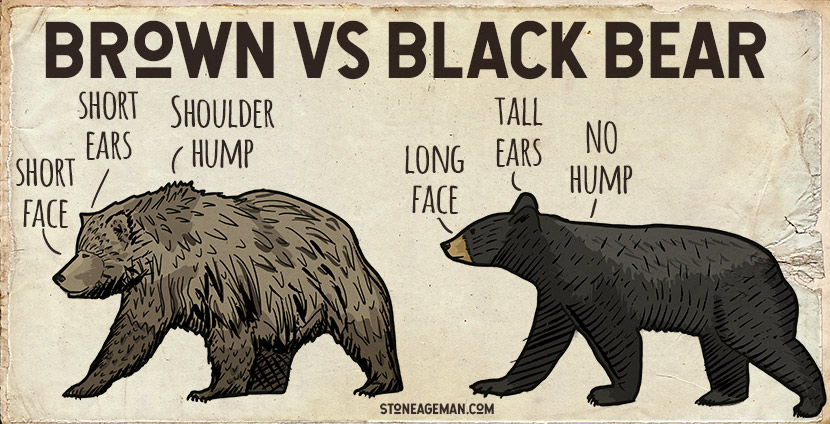
The main reason I point these out is that color is a poor indicator of what bear you’re looking at. Many black bears can range from pitch black to white! Brown bears have similar variations.
Step 2: Understand the Three Main Types of Brown Bears
Just like you’d interpret the danger of a teenage human differently than an old man, or a mother pushing a stroller, there are also big differences in bears. Let’s go through three different types of bears you might encounter.
Yearlings: These bears have just been separated from their mother. They’re like teenage kids. They don’t exactly know what to do yet and are just trying to figure out the world. Curiosity can be their downfall.
Mothers with cubs: As the saying goes, don’t mess with a mother and her cubs. You will get attacked pretty quick if you get in the way – they’re very defensive.
Lone males: Lone males generally want nothing to do with you, unless they see you as food. If they attack, you might be in trouble. This is really more true with black bears though than grizzlies, but it’s worth noting.
Types of bear encounters
Not every encounter is going to be bad. Here are a few possible outcomes of meeting a bear.
Non-encounters
In this case you probably won’t even know it’s there. It hears you and leaves the area.
Peaceful encounter
If you see the bear you can communicate with it in a calm and quiet voice. Don’t run. These situations often end with the bear just walking away.
Habituated bear encounters
Bears are smart. They get used to humans and while this might be cute at first, it can lead to trouble. Remember, bears have big teeth and claws!
Defensive Attack encounter
Most “attacks” are really defensive in nature. They just want to neutralize the threat. Unfortunately in a brown bear, a strong hit across the face could be enough to kill you. That’s why if it’s a brown bear the recommendation is to play dead. Let them know you’re not a threat anymore.
Predatory bear encounter
If a bear sees you as prey, you’re in trouble. This rarely happens with brown bears though. Black bear attacks of this kind are a different story. I’ll get to them in the next chapter.
Brown Bear Scenarios to Avoid
- Don’t get between a mother and her cubs.
- Don’t anger a bear. That means shooting it with anything, especially if it wounds the bear.
- Don’t wander alone.
- Especially don’t wander in bear country when the bears are potentially hungry or trying to beef up before winter. Late fall before they hibernate for instance is a bad time to confront a skinny bear.
- Don’t have food in your tent. Bears are curious and always looking for food.
The Most Dangerous Brown Bears
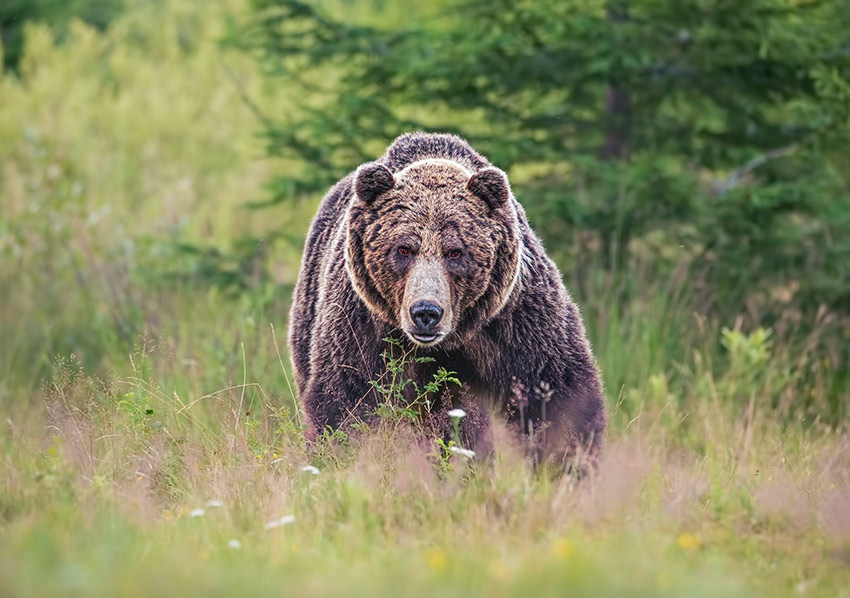
Generally, bears are peaceful. I’ll say that a thousand times. Then again, Timothy Treadwell aka. GrizzlyMan said that too and ended up getting eaten by a brown bear in Alaska. So that begs the question, what is the most dangerous brown bear? Here are a few potentially dangerous ones.
- A Threatened Mamma Bear with Cubs
- A Grumpy or Mean Bear (how are you ever going to know though)
- A Habituated Bear that relates humans with food.
- A bear that actually sees you as food.
Facts about Bear Spray:
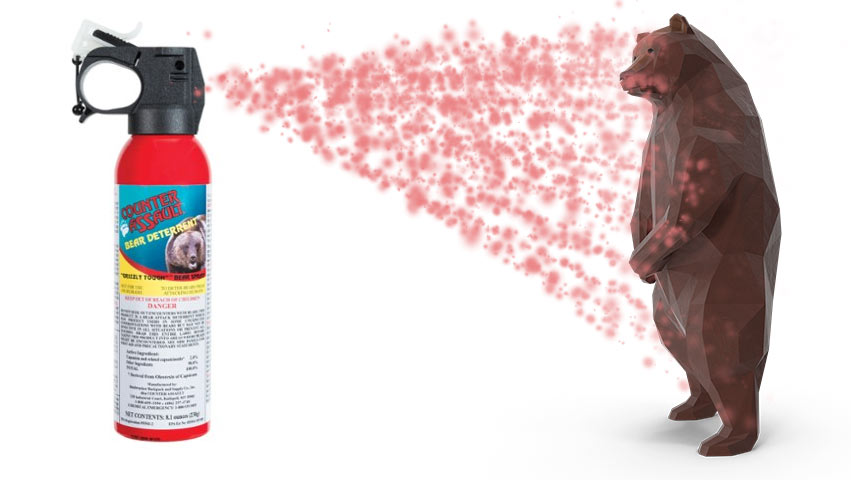
Everyone should carry bear spray in bear country. It’s the easiest and most effective way to stay safe. Here are a few things to know:
- Bear spray can can reach 40’.
- It causes burning and blindness in the eyes and burning on the skin.
- Don’t spray it on your tent, you may attract a bear. It’s only for aerial use when a bear is approaching.
- You should carry it on a holster on your body or with a carabiner.
- Every person in the group should carry one or two.
- Practice using it before you go out at least once.
- You can spray two or three short blasts per canister.
- Bear spray is different from pepper spray or mace. It contains oleoresin capsicum which is derived from peppers.
- Studies show that 98% of times bear spray was used; it was effective. Only minor injuries were sustained in the other 2% of incidents. In contrast, firearms show that only 76% of gun use was effective. That’s not great odds.
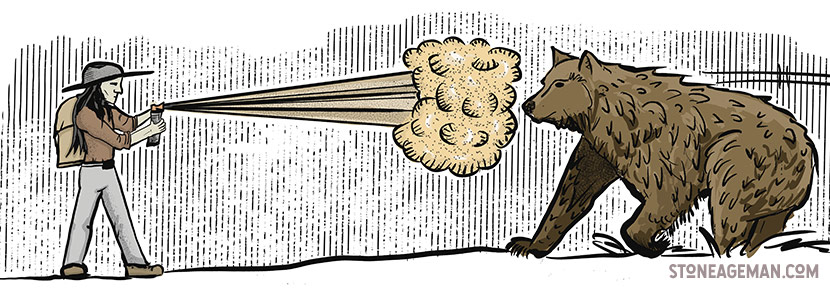
How to Survive a Brown Bear Attack?
- Use bear spray – it is very effective.
- Travel in groups of more than two.
- Do not startle or surprise a bear.
- Do not RUN. They could see you as prey.
- Communicate in a calm tone with the bear.
- Be calm yourself.
- Play dead if a brown bear does attack. It most likely is a defensive attack. (But, if it starts to eat you, that means it’s not defensive. Start fighting back!)
- Lay on your belly with hands behind your head, hopefully with a pack on. Clasp your fingers together around your neck. Keep your elbows out wide. If a bear rolls you over so that you’re face up, roll over again to be face down.
- Note: Do not play dead with a black bear. * We’ll get to that next.
Tip: Stash your food well away from bears in bear country
If you’re camping in bear country the idea is to store ALL of your food in a bear bag up a tree. Get it at least 10-12 feet off the ground and tie the rope to a different tree. This should minimize a curious bear being able to get to your stash.
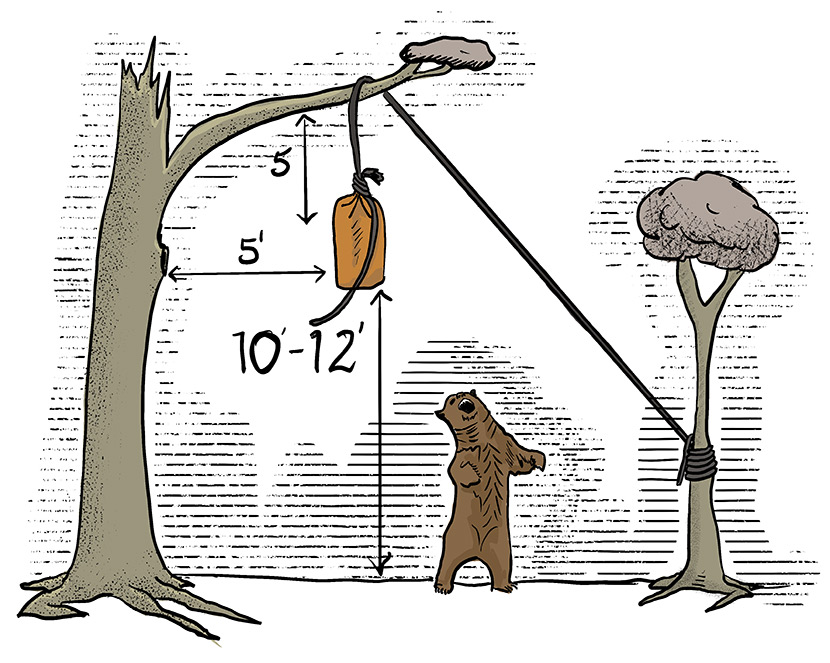
Why I wrote this article:
When I was in grad school in Hawaii, I took a bike trip riding up the west coast from Seattle to Alaska, ending in Denali National Park. We camped alongside the road and saw on average a bear every day of the trip. Sometimes we even heard them sniffing around the tent, which was, frankly, really scary.
While on a bus tour in Denali (the only way to get into that park), the driver told us over the intercom that they had dropped off a camper a few days before and that there were reports he had been attacked by a grizzly.
A month later I asked my new roommate why he had a big cut across his nose. Turns out, he was the camper who survived that grizzly encounter!
He had opened the door to his tent to find three cubs in front. He jumped out quickly to get them away. In doing so the mom saw him and charged him. The charge ended in a quick swipe to the nose and then she retreated. Luckily, that’s all that happened.
He spent the rest of the night on a cliff looking down at his tent where the mom and cubs decided to hang out. No doubt, pretty frightening.

